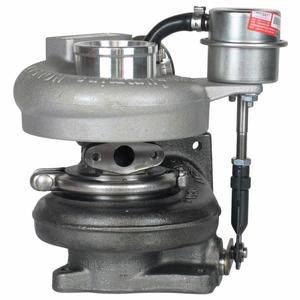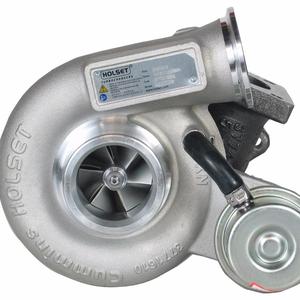(434 products available)

















































































































































































































Cummins ISF Turbocharger is a key component in many diesel and gasoline engines. It helps increase the engine's power and efficiency by forcing more air into the combustion chamber. There are many types of Cummins ISF Turbochargers, including the following:
Some specifications to consider when looking at the Cummins Turbocharger ISF are as follows:
Displacement:
Turbochargers are often categorized according to the displacement size of the engine they are designed to be used with. Displacement refers to the size of the engine. The Cummins ISF Turbocharger may have a displacement of between 1.5 and 5.0 liters, depending on the model.
Tier 4 final:
Tier 4 final specifies the emissions regulations that the turbocharger complies with. The Cummins ISF Turbocharger is designed to meet Tier 4 final emissions standards, which means it produces very low emissions and is environmentally friendly.
Power ratings:
The power ratings of the Cummins ISF Turbocharger range from 55 to 173 horsepower. This means that the turbocharger can be used to increase the power of engines that produce between 55 and 173 horsepower.
Torque:
The torque of the Cummins ISF Turbocharger varies depending on the model. The torque ranges from 130 to 400 Nm. This means that the turbocharger can be used to increase the torque of engines that produce between 130 and 400 Nm of torque.
Length and width:
The length and width of the Cummins ISF Turbocharger vary depending on the model. The length ranges from 100 to 170 mm, and the width ranges from 50 to 80 mm. This means that the turbocharger is compact and can be easily installed in most engines.
Weight:
The weight of the Cummins ISF Turbocharger also varies depending on the model. The weight ranges from 1.5 to 4.5 kg. This means that the turbocharger is lightweight and does not add much weight to the engine.
Maintaining the Cummins ISF Turbocharger is a vital part of ensuring the longevity of the turbo itself and the engine it is attached to. Here are a few things to keep in mind:
Oil:
Oil is a big part of the Cummins ISF turbocharger's upkeep. It's recommended to check the oil level before starting the engine daily. Engine oil lubricates the turbo's moving parts, ensuring everything runs smoothly. It's also advised that the oil and oil filter be changed regularly to keep the turbo healthy.
Air:
The air filter is another important component to keep in mind while maintaining the turbocharger. It is recommended to inspect the air filter for damage weekly and replace it if necessary. A clean air filter is vital for the car's engine health because it ensures clean air goes into the turbocharger, preventing dirt and debris from damaging it.
Cooling:
The coolant level should be checked every week to ensure the turbo doesn't overheat. Overheating can cause severe damage to the turbo and the engine, leading to expensive repairs. It's also recommended to flush the cooling system every two years to remove any buildup and ensure it works efficiently.
Following these maintenance tips can help ensure the Cummins ISF turbocharger lasts a long time. Ultimately, this will lead to better performance and savings in the long run.
It’s a no-brainer that choosing the right turbo for a vehicle can be a daunting task, but it doesn’t have to be. Here are some factors to consider when choosing a Cummins ISF turbocharger:
Understand the needs of the target market:
First, understand the needs of the target market. What type of vehicles do they have? What is the purpose of their vehicles? Is it for hauling heavy loads, racing, or off-roading? Knowing the needs of the target market will help choose the right turbocharger that will suit their needs.
Consider the size of the turbocharger:
When choosing a turbocharger, size is an important factor to consider. A larger turbo will generate more power, but it may have a lag before the power kicks in. On the other hand, a smaller turbo will spin quickly and generate power instantly, but it won’t produce much power. Choose a turbo that will suit the needs of the target market.
Price:
When choosing a turbocharger, price is also an important factor to consider. There are many turbochargers in different price ranges, so choose one that is within the budget but also meets the needs of the target market.
Some turbochargers have variable geometry, which allows the vehicle to have good performance at low RPMs. The VGT turbo by Cummins helps to improve fuel efficiency and lower emissions. The turbocharger by Cummins ISF requires proper maintenance for it to last. Here are some steps on how to replace a turbocharger:
Safety precautions:
Ensure that the vehicle is parked on a flat surface. The engine should be turned off, and the users should give it time to cool. The turbocharger can get very hot, and touching it can cause burns. Wear gloves and safety goggles when handling the turbo to avoid injuries.
Gather the necessary tools:
Users should have a socket set, wrench set, torque wrench, pliers, and screwdriver set. It is also important to have a new turbocharger kit and gasket when replacing the old one. The gasket helps to provide a seal between the turbo and the engine.
Remove the old turbo:
Start by disconnecting the exhaust pipes and the oil feed and return lines. Then, remove the intake pipes and electrical connections. Use a socket set and wrench set to remove the bolts holding the turbo to the manifold. Carefully lift the turbo out of its place and set it down.
Install the new turbo:
Prepare the new turbo by installing the oil lines and connecting the waste gate actuator. Then, carefully place the new turbo onto the manifold and secure it with bolts. Make sure to tighten the bolts evenly to prevent leaks. Reconnect the electrical connections, intake pipes, and exhaust pipes.
Final steps:
Once the new turbo is installed, users should prime the oil system by turning the ignition on without starting the engine. This helps to circulate oil through the lines and the turbo. Start the engine and let it run for a few minutes. This helps to ensure that the turbo is working properly. Check for any leaks or loose connections and fix them immediately.
Q1. How can someone know if their turbocharger needs to be replaced?
A1. There are several indications that the turbocharger might need replacement. These include a significant drop in engine performance, excessive exhaust smoke, strange noises coming from the turbo when accelerating, and the check engine light being activated. If any of these symptoms are noticed, it's essential to have the turbo checked as soon as possible.
Q2. Should the turbo be upgraded when replacing the engine?
A2. It depends on the requirements of the new engine setup. For most standard builds, the existing turbo is sufficient. An upgrade may be needed for high-performance goals or when the current turbo is worn out. Researching compatible options beforehand is advisable if a turbo upgrade is desired.
Q3. Is it better to buy a new, used, or refurbished turbo?
A3. A brand-new turbo is most reliable and hassle-free, albeit more expensive. A refurbished unit can be almost as good at a lower price. A used turbo carries some risk of unknown wear but appeals to budget-conscious buyers. Thoroughly inspecting any secondhand parts provides maximum assurance of quality.
Q4. How long does it take to replace a turbocharger?
A4. Replacing a turbo can take anywhere from 2 to 8 hours depending on the vehicle's design and the turbo's location. Accessible turbos are quicker to swap. Allowing sufficient time for a proper install is recommended if having it done professionally.
Q5. Can anyone change a turbo themselves?
A5. With basic mechanical skills and following detailed guides, it's possible to DIY a turbo replacement. Many videos and manuals explain the process step-by-step. Adequately researching the topic before proceeding is critical, however, as even minor errors can damage the new turbo.